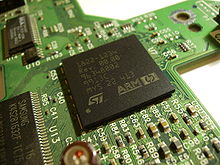Financial Performance Relationships: Arm Holdings and Apple
 The relationship between Apple, the biggest company on the planet, and ARM Holdings, a British semiconductor design firm, might not be apparent at first glance. But ARM provides the brains behind in most Apple products, by designing the processor chips for iPhones, iPads and a host of other indispensable gadgets.
The relationship between Apple, the biggest company on the planet, and ARM Holdings, a British semiconductor design firm, might not be apparent at first glance. But ARM provides the brains behind in most Apple products, by designing the processor chips for iPhones, iPads and a host of other indispensable gadgets.
It doesn’t manufacture them directly, though. Instead, ARM Holdings licenses their designs to Samsung chipmakers, who go on to produce the product for Apple. This complex relationship becomes a bit clearer when you take a close look at the stock performance and differing business models of the two companies.
Head to Head Comparison
Apple, with its monster market cap of nearly $600 billion dollars, clearly plays in an entirely different league than ARM Holdings, with its more modest $20.23 billion capitalization. Still, the biggest difference between the two businesses isn’t sheer scale but instead lies in their business models. Apple is primarily a retail device and consumer-oriented business, while ARM Holdings markets to the manufacturers and engineers of the tech world. That leads to clear differences, like Apple’s predictable late-November share price spike, as well as ARM Holdings’ sluggish Springtime sales, when device manufacturers are selling their new models rather than designing the next big thing.
Although ARM Holdings does benefit from Apple’s success, the inverse isn’t true. Apple is much more tied to the broader consumer market than the ups and downs of its chipmakers. Smart investors would do well to pay attention to the way that ARM Holdings is positioning its chips to be the de facto standard for internet-enabled devices around the home, tying them more closely to the retail market and stabilizing their share price somewhat because of broader adoption. In a recent shareholder meeting the CEO of ARM Holdings, Simon Segars, noted that‘the 41 processor licences signed in Q2 were driven by demand for ARM technology in smart mobile devices, consumer electronics and embedded computing chips for the Internet of Things’.
Find out more about the financial markets at one of the top sites for financial spread betting.
Special Considerations
Since ARM Holdings is essentially a broker of their intellectual properties, it makes sense that they swim in much larger waters than even Apple. For years, ARM processors have powered everything from mobile devices to servers, and a huge array of companies have relied on their technology. Times change, however, and the products offered by ARM Holdings are falling out of style, replaced by designs based in more modern architecture.
To the investor, that means that it’s important to pay attention to the larger market conditions. Although ARM isn’t as fashionable as it once was, it still occupies a favoured place in providing the technology behind the processors in low-end smartphones and tablets. Considerations like a weakening dollar or struggling economic growth could actually cause more widespread consumption of ARM-based devices, causing a spike in the share price of ARM Holdings even when the broader market seems weak.
Apple, being the retail giant that it is, can be a bit easier to predict. Share prices spike when they release new tech, as they did in April of 2014 when the stock soared 10 points. To a certain degree this release schedule is built into the share price, although it’s not uncommon to see spikes when consumers are excited about the newest Apple device. Basing your investment completely off of the manufacturing release schedule doesn’t always work well, since a consumer flop can lead to surprised and upset investors.


